Human-induced climate change and environmental degradation is no longer a nebulous future threat. It’s here, and it threatens global economic development, global health, and global security. Last year, the North Atlantic Treaty Organization declared climate change a “defining challenge of our time,” posing dangers to the security of allied nations and elsewhere.1 Given its influence over global supply chain practices, which account for a significant portion of global emissions, CBP hopes to help move the needle toward more sustainable trade through the Green Trade Strategy, which the agency launched in 2022.
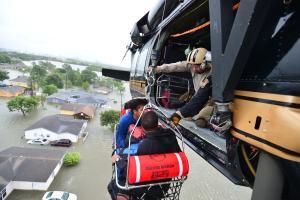
“Climate change has implications for every aspect of CBP’s core mission … we have no choice but to approach this as an opportunity for positive action, innovation and risk-informed decision making. Unchecked global warming threatens the welfare and livelihood of all those who populate this planet … the future of trade itself is jeopardized by the climate impacts that we inevitably face,” said CBP’s Director of Green Trade Lea-Ann Bigelow.
Customs agencies have long served as the first line of defense against the importation of products that harm the environment and are now uniquely positioned to make an impact in encouraging and enforcing cleaner, more environmentally sustainable international trade flows.
That’s why CBP launched the Green Trade Strategy. Through the strategy, CBP has established a proactive model to combat the negative impacts of climate change and environmental degradation in the context of the trade mission, by incentivizing the reduction of carbon emissions and the adoption of sustainable practices by industry, strengthening CBP’s environmental enforcement posture, and improving the climate resilience and resource efficiency of CBP’s own operations.
CBP’s trade mission encompasses thousands of employees, from international trade analysts to agriculture specialists, and the strategy will require participation across the CBP enterprise. This vast scope is reflected in the strategy’s four pillars:
- Incentivize Green Trade;
- Strengthen Environmental Enforcement Posture;
- Accelerate Green Innovation; and
- Improve Climate Resiliency and Resource Efficiency.
With these four pillars, the strategy provides a framework for future action. Success will require buy-in and collaboration from other federal agencies, non-governmental organizations, academia, foreign governments, and the private sector.
Fortunately, the agency is not starting from scratch and is working to implement the goals of the Green Trade Strategy in the context of larger government and private sector efforts. CBP is supported in its green trade ambitions by numerous Presidential Executive Orders (for example, E.O. 14008 “Tackling the Climate Crisis at Home and Abroad”), and provisions in the Inflation Reduction Act, the Bipartisan Infrastructure Law, and more. The Green Trade Strategy also aligns with the Department of Homeland Security’s Strategic Framework for Addressing Climate Change.
Pillar 1: Incentivizing Green Trade: Green Trade Innovation and Incentives Forum
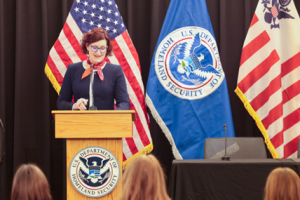
One of the Green Trade Strategy’s four pillars is “Incentivizing Green Trade” – which means developing meaningful trade facilitation mechanisms and benefits to accelerate private sector climate mitigation and sustainability efforts. It underscores the necessity for CBP to work with industry, academia, non-governmental organizations, partner government agencies, and others in realizing its vision for a greener, more sustainable, and more resilient trade landscape.
To further this goal, the Office of Trade’s Green Trade Division hosted the Green Trade Innovation and Incentives Forum on July 11, 2023. The event served as a call to action for working toward sustainable supply chains.
The forum’s impressive lineup of speakers from government, the private sector, and CBP’s international counterparts included CBP’s Senior Official Performing the Duties of the Commissioner, Troy A. Miller, along with the Office of Trade’s Executive Assistant Commissioner AnnMarie R. Highsmith; Ambassador Jayme White, Deputy U.S. Trade Representative; Kimberlee Stamatis, Assistant Secretary, Customs and Trade Policy, Australian Border Force; Tim Figures, Associate Director of Global Trade and Investment at the Boston Consulting Group; and Vaishali Udupa, Commissioner for Patents, U.S. Patent and Trademark Office.
In her remarks, Highsmith summed up the reason behind the forum: “We are … here today because we have a shared responsibility to act, to examine, and in some cases rethink and ultimately remake the way we are doing business. Our collective actions will add up to major impact, and we have an obligation to the communities we serve to act in a coordinated fashion, building transformative yet pragmatic partnerships.”
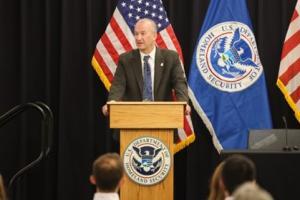
The event’s Trade Sustainability Leadership Showcase Panel allowed industry executives from several global trade entities to share their current green initiatives, including the work they are advancing with their own suppliers and value chain partners to reduce Scope 3 greenhouse gas emissions and ensure sustainable and ethical sourcing, as well as discuss how potential incentives and opportunities for public-private partnership could further their efforts.
Panelists included senior leadership from Under Armour, Expeditors International, DHL Express Americas, and REI Co-op. Another panel – “Called to Action: Interagency Investments in Global Sustainability” – demonstrated the need for a whole-of-government approach to green trade and included U.S. government leadership working to advance trade sustainability, with representatives from CBP’s Customs Trade Partnership Against Terrorism Program, the DHS Science & Technology Directorate, the U.S. Department of Agriculture, the Environmental Protection Agency, and the U.S. Agency for International Development.
In addition, 26 individual commentors from industry and the non-profit sector were given the opportunity to read their comments and proposals on the themes of green trade incentives, green trade innovation and green data as a strategic asset before a panel of government executives, demonstrating the value of a variety of voices in finding and implementing climate solutions. (A full list of these commenters are available on the Green Trade Innovation and Incentives Forum page.
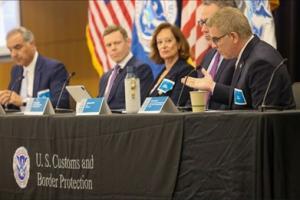
The forum served as the beginning of a conversation that will grow increasingly nuanced and productive as CBP continues to work closely with its stakeholders and partners to implement change. Nearly 1,000 attendees spanning more than 250 companies, over 30 U.S. federal, state and local government agencies, and more than 35 countries attended the event. Bigelow called it “a powerful jumpstart to CBP’s efforts to build a cross-sectoral community of green trade action and identify tangible incentives and innovations that will help trade entities yield a return on their existing investments in supply chain sustainability, while encouraging those same entities to make additional investments in zeroing out carbon emissions and waste.”
Pillar 2: Strengthening Enforcement
CBP designed the strategy while considering the agency’s existing strengths and core capabilities as well as known resource and capacity gaps, creating a formal framework for future action while building on work that is already taking place. For instance, CBP has long enforced laws against natural resource crimes including illegal logging, illegal mining, illegal, unregulated and unreported fishing and wildlife trafficking, as well as agricultural inspections, in which CBP is a world leader.

One of CBP’s existing strengths is a robust environmental enforcement program. In support of the Green Trade Strategy, CBP’s Civil Enforcement Division enforces environmental laws working alongside organizations like the U.S. Fish and Wildlife Service, the National Oceanic and Atmospheric Administration, the Environmental Protection Agency, and others.
The Civil Enforcement Division also enforces environmental regulations in the United States-Mexico-Canada Agreement, which authorizes CBP to enforce regulations of potentially harmful chemicals like chlorofluorocarbons, which can harm the ozone layer, and contains a number of other environmental provisions designed to lessen the environmental impact of trade between the signatory countries.
However, environmental laws can be notoriously difficult to enforce. Companies responsible for illegal logging and deforestation in the Amazon, for example, will disguise their illegal operations by changing their names until CBP catches up by finding new ways to the identify them.
Not only do these crimes threaten the environment and the air we breathe, but they are also major sources of income for organized crime entities, with revenues that can even come close to those of the illegal drug trade. Criminal organizations often use the proceeds from environmental crimes to fund a variety of criminal activities as well as violent conflicts such as Russia’s invasion of Ukraine – where Russia is collaborating with Sudan’s military government to exploit Sudanese gold resources to fund the war.2 It’s clear that while natural resource crimes hurt the economy and lead to job loss, they also pose national security threats, financing terrorism and funding other forms of organized crime.
When asked what conscientious consumers can do in the face of these threats, Mark Ziner, Director of the Civil Enforcement Division points out, it’s important for people to ask themselves where their goods are coming from: “Where are you buying them? Are they sustainable? Clean of illicit activity? Is the good that you’re buying harming the Amazon?” Consumers can leverage their buying power to hold industry accountable.
By strengthening its environmental enforcement, CBP hopes to prevent these crimes from being committed at all, recognizing that once these goods reach U.S. shores, the damage to the environment has already been done.

Protecting America’s Farms and Forests
Another crucial enforcement area is CBP’s agricultural program. CBP’s Office of Field Operations has over 2,700 agriculture specialists working in ports of entry all over the United States under the oversight of the Agriculture Programs and Trade Liaison directorate, or APTL. APTL maintains specific authorities related to the protection of animal and plant health, and often works with the U.S. Department of Agriculture’s Animal and Plant Health Inspection Service, known as APHIS.
APTL helps preserve U.S. forests and landscapes and protects crops and the nation’s food supply. For example, agriculture specialists inspect wood packing materials like pallets for wood-boring pests, which can overtake forest systems, destroying trees and spreading to surrounding plants, forcing authorities to cut and clear entire forests to remove the risk.
APTL engages in concerted outreach efforts to provide the trade community with information on the risks associated with wood packaging materials and regulation compliance. John Sagle, Deputy Executive Director of APTL, explained that if CBP identifies a live wood-boring pest in an importation, the entire shipment must be re-exported, leading to what should have been an unnecessary global movement of cargo, a massive inefficiency.
Pillar 3: Green Innovation
CBP is always seeking out new technologies and practices to improve efficiency – now the agency is looking for technological improvements that also benefit the environment. For example, CBP recently updated its Automated Commercial Environment – the electronic system that tracks all cross-border trade in the United States – to include the Truck Manifest Modernization deployment.
Prior to this update, fewer than 40% of commercial trucks could be processed in under 30 seconds at all ports of entry. With 45,000-55,000 trucks crossing the border each day, that meant a lot of trucks sitting idle while emitting harmful chemicals. As a result of the Truck Manifest Modernization deployment, more than 99% of trucks clear CBP processing in under 30 seconds. Not only does this new update save time and money, but it also reduces pollution.
CBP’s Unified Cargo Processing and Free and Secure Trade, known as FAST, programs also create efficiencies that benefit the environment and create time and cost savings for the trade community. A 2019 study led by the Environmental Protection Agency at the Nogales-Mariposa Land Port of Entry found that the Unified Cargo Processing and Free and Secure Trade programs substantially reduce commercial truck queue crossing times and inspection delays, delivering an approximately 85% reduction in carbon emissions in U.S. bound traffic.3
CBP is working on a number of emerging technology concerns through the DHS Silicon Valley Innovation Program, which funds innovative work with private sector partners to develop and adapt commercial technologies for homeland security use cases. Supply chain traceability and “environmental passport” pilots are helping CBP and its partners think about how technology can enable responsible value chain stakeholders to quantify and report emissions and scarce natural resource usage end-to-end across organizational boundaries.
Pillar 4: Climate Resiliency and Resource Efficiency – Looking Inward
The agency is also looking for ways to innovate its own facilities to increase sustainability.
CBP’s mission – to protect U.S. borders – naturally includes protecting against environmental threats because of the potential harm they pose to the climate, local ecosystems, and the U.S. economy. But what about CBP’s own impact on the environment? An agency as big as CBP, with more than 60,000 employees nationwide and 328 ports of entry, leaves a significant footprint.
Part of the Green Trade Strategy looks to mitigate CBP’s impacts on the environment, turning operations and facilities greener. This coincides with an overall U.S. government push to upgrade buildings, facilities and assets to withstand climate change while contributing to climate solutions. CBP plans to execute an energy savings project along the northern border to provide CBP facilities with more energy efficiency.
Chris Oh, Director of the Integrated Services Division at CBP’s Office of Facilities and Asset Management, explained that strengthening the resilience and sustainability of trade infrastructure and assets means to prepare and adapt to changing conditions, and then recover from disruptions. In practice, this could look like operating with more than one type of fuel; reinforcing or elevating some of the coastal assets and infrastructure vulnerable to coastal flooding and storms; and supply chain processes that can be made more efficient. Small changes can make a big difference.
CBP received approximately $24 million in DHS funds to complete a technical demonstration on Electric Vehicles and Electric Vehicle Supply Equipment. This is the first step prior to embarking on a full-scale program in support of meeting the DHS goal of electrifying 50% of vehicles by 2030. CBP’s transition from internal combustion engines to electric vehicles will have a significant impact on DHS’ overall emissions, since CBP’s 23,000 vehicles account for about 47% of the entire DHS fleet.
CBP is also working to reduce its carbon footprint in other ways. In 2022, the agency achieved a 69.6% reduction in greenhouse gas emissions from its 2008 levels, surpassing its goal of 38%. CBP’s top sources of emissions are electricity consumption from utility companies, building fuel consumption and fleet fuel consumption, according to Oh.
The Bipartisan Infrastructure Law provides CBP and the General Services Administration with $3.4 billion to modernize land ports of entry. As a result of the law, 26 facilities in 11 states will see improvements through sustainability and emissions reduction projects that improve mission readiness by increasing resilience to climate change.
CBP ports of entry are key in the agency’s efforts to address climate change, since each day, approximately 868,867 passengers and pedestrians pass through CBP facilities as they enter the United States, whether by air, land, or sea. CBP also processes 91,605 truck, rail, and sea containers every day, and 226,589 privately owned vehicles.
CBP leases many land ports of entry from GSA and partners with them to modernize facilities, providing input on mission needs in building and landscape design. And that collaboration is paying off. A 2019 Columbus, New Mexico Port of Entry renovation achieved net-zero emissions. The renovated project used six to seven thousand tons of recycled concrete and ensured that 100% of the facility’s paving and roofing can deflect solar energy to keep it cool, reducing the need for climate control.
Likewise, the San Ysidro Port of Entry, with renovations completed in 2021, sets a gold standard in sustainability for U.S. government facilities, and serves as a model for future port updates.
San Ysidro – Combining Mission Readiness and Climate Efficiency
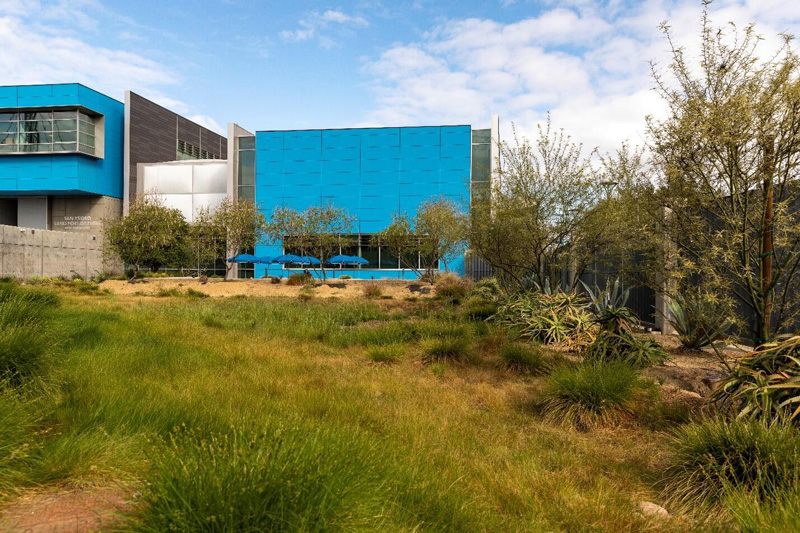
The port, originally constructed during the Nixon administration, underwent a redesign when it became evident that the old infrastructure was no longer sufficient to accommodate CBP’s mission or the increased travel demands that naturally accompanied population growth.
Up to 25,000 pedestrians a day could wait hours to cross the border prior to the renovations. The lag time resulted in lost productivity and threatened the local economies in Tijuana and San Ysidro. Replacing the port took over a decade, during which GSA conducted environmental impact studies and community outreach to ensure that the port served the community in which it resides.
The goal became to build a “port of the future.” The project was an opportunity to explore new technologies, from solar photovoltaic panels that generate electricity to a water reclamation system. No detail was left unaccounted for as ethylene tetrafluoroethylene materials were installed to eliminate the need for daytime lighting and provide shade and comfort for the officers and those passing through the port. The use of white paint on surfaces helps to deflect heat, and LED light reduces the amount of electricity needed to run the port.
Even the landscaping with drought resistant plants became part of the design through xeriscape landscaping, which uses less water and preserves soil integrity. Other sustainable features include a solar thermal hot water system, a geothermal heat exchange system, ultra-low flow water fixtures, a rainwater retention and reuse system and an onsite wastewater retention treatment system.
The construction efforts were so successful they earned a Leadership in Energy and Environmental Design (LEED) Platinum certification, an internationally recognized standard.
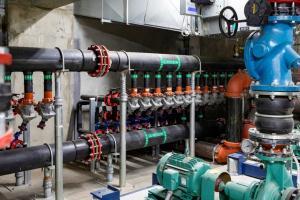
As with any major structure, wear and tear is bound to happen over time – but fortunately the materials are durable and sustainable, and San Ysidro is a great example of how cost effective going green can be. While the port required a substantial investment up front, maintenance is mostly straightforward, and the government has been able to regain its initial investment through cost savings over time.
San Ysidro is indeed proving to be a port of the future, as lessons learned during its redesign are already being incorporated into future construction projects across the nation. This places it alongside ports around the world like the Port of Rotterdam, the largest port in Europe, which is looking to attain zero emissions by 2050, and the Port of Vancouver, which provides incentives to ship owners to reduce emissions.4
Legislation like the Bipartisan Infrastructure Law, which requires the use of low-embodied concrete and asphalt with reduced carbon footprints, is generating ever greater momentum for sustainable modernization efforts. A current project at the Otay Mesa Port of Entry, for example, involves replacing the north-bound vehicle inspection queuing area with low-embodied concrete, which lasts longer and doesn’t need to be replaced as often.
Javier Fernandez, Land Ports of Entry Communications Specialist at GSA explained that as an agency, CBP is always looking for ways to increase sustainability efforts. Of course, there is always a need to balance any renovation project with the need for CBP to carry out its primary mission. Fernandez notes that the renovations have improved CBP’s ability to do its work, yielding significant benefits to travelers and businesses alike. For example, port renovations mean cars are spending less time waiting for inspection, reducing emissions.
Moving Forward Together
Tackling climate change is not a problem anyone can solve alone, no matter how good their intentions. As Highsmith said at the Green Trade Innovation and Incentives Forum, “Climate change poses a significant challenge to CBP’s trade mission and is understood to be both a national and economic security concern. The effects of climate change threaten both military and civilian infrastructure and operations,” and it’s time to shift from “thoughtful planning to pragmatic action.”
CBP’s Green Trade Strategy opens the door to solutions and serves as an invitation to others to join with CBP and other government agencies to further the initiative and learn from each other’s best practices. Given the scope of the Strategy, solutions necessarily call for a wide range of actions and expertise. Fortunately, CBP has a road map drawn from both existing strengths and a vision for the future.
[1] North Atlantic Treaty Organization (2021). NATO Climate Change and Security Action Plan. Retrieved from: NATO – NATO Climate Change and Security Action Plan, 14-Jun.-2021
[2] Nima Elgabir et. al., (2022), Russia is Plundering Gold in Sudan to Boost Putin’s War Effort in Ukraine. CNN. Retrieved from www.cnn.com, July 18, 2023.
[3] Unified Cargo Processing allows for CBP officers on the U.S. side of the border to work alongside their Mexican counterparts to jointly inspect U.S.-bound Cargo. The FAST program allows for expedited processing of low-risk commercial shipments entering the U.S.
[4] T.R. Walker, M. Adams (2021). Retrieved from: theconversation.com.







